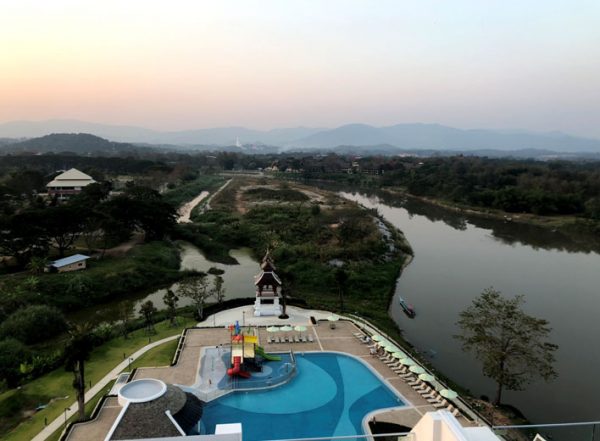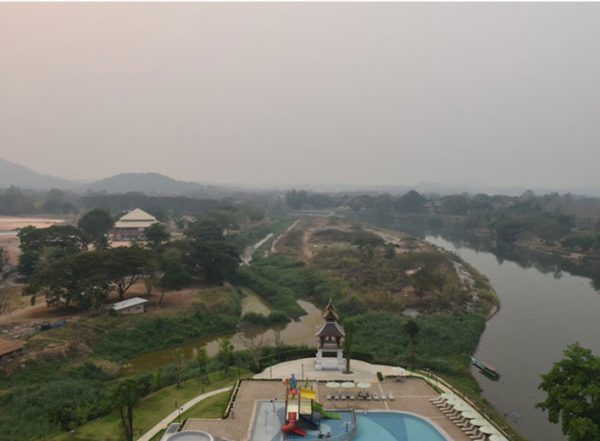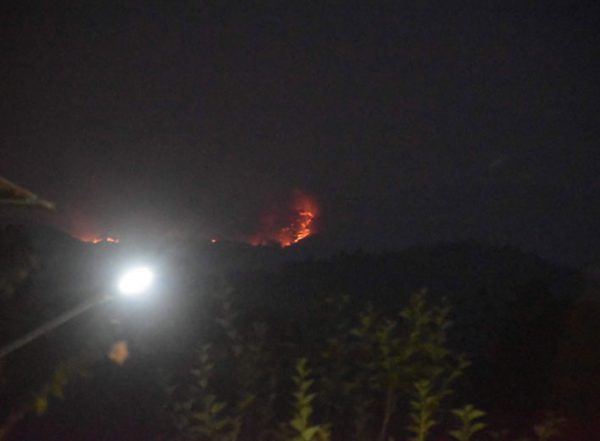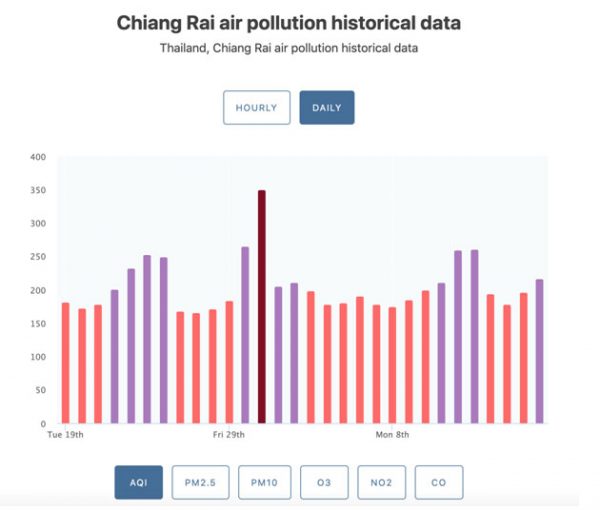CHIANG RAI, 18 April 2019: As Thailand’s Songkran festival came to a close earlier this week, hoteliers in this far north town reported dramatic declines in room and guest spend of around 20%.
They blamed the plunge entirely on an unprecedented smog crisis partly caused by the wholesale burning of hillside forests to clear land for new plantations.
A historical data chart on the Air Visual air quality index app shows Chiang Rai has consistently reported heavy smog for the last 30 days (19 March to 17 April) at levels that were flagged hazardous to health.

The plunge into a smoggy March came on the heels of a positive tourism performance during the first two months. Chiang Rai’s airport welcomed 31,155 travellers on direct international flights in February an increase of 44.25%
In January, 25,914 travellers arrived on international flights an increase of 51.64% due in part to the introduction of new direct flights from Singapore Kuala Lumpur and Macau.
When domestic flights were included Chiang Rai performed well with 283,55 passengers in January, up 5% and 262,473 in February an increase of 11.84%.
But across Chiang Rai province, the smog crisis continues to threaten health and economy with the air quality index peaking at 300 in Chiang Rai’s city centre Wednesday. Forecasts suggest the province could remain in the red or purple zones for weeks to come.
Hoteliers put a brave face on a crisis that has quickly reversed positive financial results reported in January and February that showed performances well ahead of the same months last year.
That trend slipped into reverse gear by mid-March and even the most optimistic of the town’s hoteliers admit business is down 11% against the run of play monitored year-on-year.
But these are conservative comments from hoteliers who clearly don’t believe what they are saying, or feel it is not appropriate to share factual information with the media. Some are more forthcoming recognising the province has a crisis on its doorsteps that will damage the economy and public health for decades to come.

A bad reputation for delivering poor air quality kills a destination that promotes its clean unspoilt natural beauty.
They admit occupancy is adrift by around 20% “but guest spend could be down as much as 25%.”
Riverside hotels are considered a reliable benchmark for the city’s hotel industry as they command the highest room rates and generate robust F&B sales. Elsewhere, hotels were reporting heavy cancellations and the fear is that the already short November to April peak season has now shrunk by a month.
“These are educated guesses,” said one hotelier at a riverside hotel. “Hotels were ahead in the two months before the smog crisis, possibly by five to six points year-to-date. But a quick telephone around our competitive set shows at least a drop of 11 to 12% on previous revenue forecasts.”
But then he adds the inevitable asterisk. “My educated guess would place the overall room and F&B revenue loss at between 20 to 25%.”
That’s as accurate as hoteliers are likely to be in an industry that is highly competitive and in a city where hoteliers face off in combat rather than collaborating to battle a crisis.
In contrast to the negative story that emerged in the booking and revenue reports, just a week ahead of the festival, the Airports of Thailand CEO, Nitinai Sirismatthakarn, told the Bangkok Post Chiang Mai and Chiang Rai had nothing to fear from the “haze.”

Claiming the “northern haze is no obstacle,” the AoT chief estimated 80,000 travellers would descend on Chiang Rai town 12 to 17 April, around 11,400 passengers a day, representing an improvement of 37% on the 2018 festival week.
AoT also estimated around 246,000 travellers would fly to Chiang Mai during the festival week, up 19.7% on last year.
The Tourism Authority of Thailand estimated 3.1 million tourists (domestic and international) would travel to destinations in the country during the festival.
Like the hoteliers, the narratives are educated guesses based on a positive thread that flies in the face of the facts presented in the daily AQI counts. North Thailand’s two top destinations are in serious trouble. The smog label will stick discouraging tourists and long-stay retirees if no action is taken to end the annual burning season.
Ahead of the Songkran festival, travellers could make last minute changes to their itineraries switching to South Thailand’s beach destinations where the AQI rating was in the blue. But for those who visited Chiang Mai and Chiang Rai they encountered air quality that residents said they had never experienced over two to three decades of living in North Thailand.
Their greatest fear, based on the inertia of national government and the provincial office to tackle the crisis, is that this is now the annual norm; a deliberating two-month long “smog season.”







